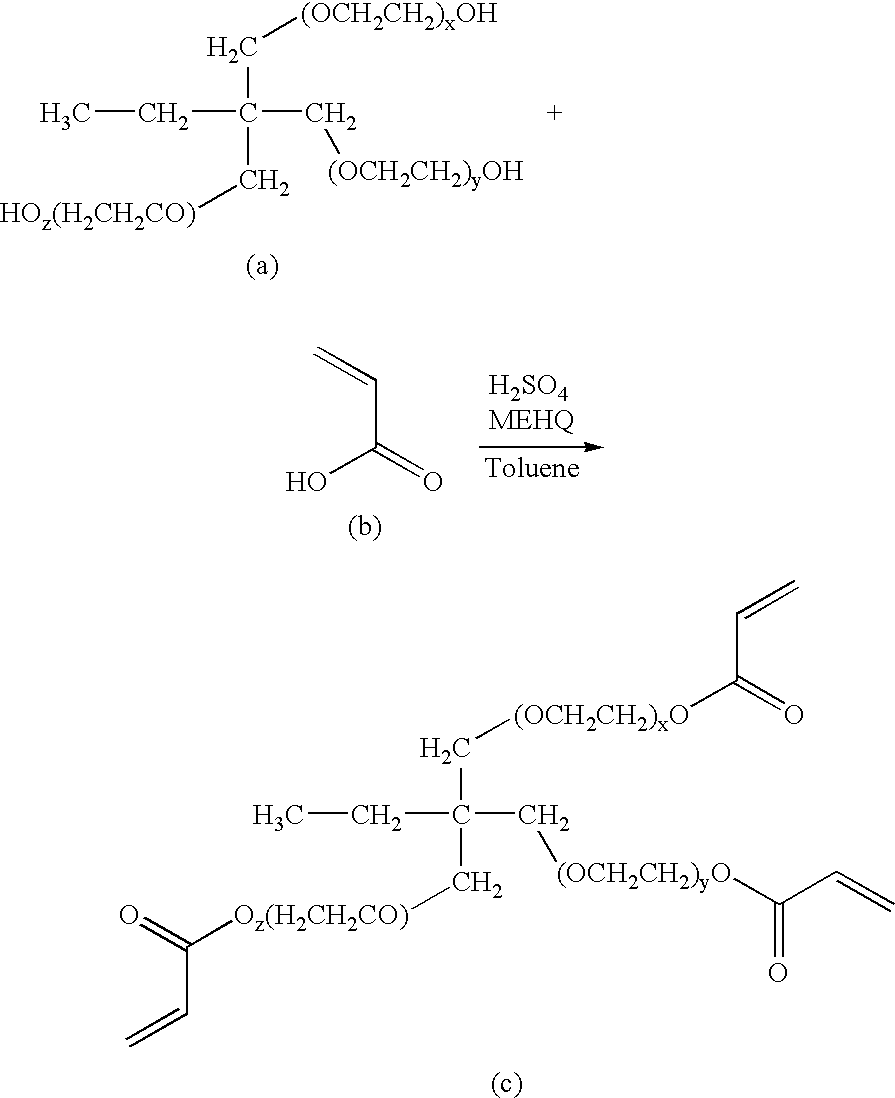Crosslinkable macromers
a macromer and polymer technology, applied in the field of macromer polymerization preparation of matrices, can solve the problems of uncrosslinked matrices, complicated production methods, and limited number of acceptable methods of producing polymer networks, and achieve the effect of improving toxicity
- Summary
- Abstract
- Description
- Claims
- Application Information
AI Technical Summary
Benefits of technology
Problems solved by technology
Method used
Image
Examples
example 1
Synthesis of 7-Methyl-9-oxothioxanthene-3-carboxylic Acid Chloride (MTA-Cl)
[0121] The 7-methyl-9-oxothioxanthene-3-carboxylic acid (MTA), 50.0 g (0.185 mol), was dissolved in 350 ml of toluene and 415 ml (5.69 mol) of thionyl chloride using an overhead stirrer in a 2 liter 3-neck round bottom flask. N,N-Dimethylformamide (DMF), 2 ml, was added and the reaction was brought to reflux for 2 hours. After this time, the mixture was stirred at room temperature for 16 hours. The solvent was removed under vacuum and the product was azeotroped with 3×350 ml of toluene to remove the excess thionyl chloride. The product was recrystallized from 800 ml of chloroform and the resulting solid was placed in a vacuum oven for 16 hours at 45° C. to complete removal of solvent. The isolated product weighed 45.31 g (85% yield) and nuclear magnetic resonance spectroscopy (NMR) confirmed the desired structure. This product was used for the preparation of a photoreactive monomer as described in Example 2....
example 2
Synthesis of N-[3-(7-Methyl-9-oxothioxanthene-3 -carboxamido)propyl]methacrylamide (MTA-APMA)
[0122] The N-(3-aminopropyl)methacrylamide hydrochloride (APMA), 4.53 g (25.4 mmol), was suspended in 100 ml of anhydrous chloroform in a 250 ml round bottom flask equipped with a drying tube. After cooling the slurry in an ice bath, the MTA-CL, 7.69 g (26.6 mmol), was added as a solid with stirring. A solution of 7.42 ml (53.2 mmol) of triethylamine (TEA) in 20 ml of chloroform was then added over a 1.5 hour time period, followed by a slow warming to room temperature. The mixture was allowed to stir 16 hours at room temperature under a drying tube. After this time, the reaction was washed with 0.1 N HCl and the solvent was removed under vacuum after adding a small amount of phenothiazine as an inhibitor. The resulting product was recrystallized from tetrahydrofuran (THF) / toluene (3 / 1) and gave 8.87 g (88.7% yield) of product after air drying. The structure of the compound was confirmed by ...
example 3
Preparation of N-Succinimidyl 6-Maleimidohexanoate (MAL-EAC-NOS)
[0123] 6-Aminohexanoic acid, 100.0 g (0.762 moles), was dissolved in 300 ml of acetic acid in a three-neck, 3 liter flask equipped with an overhead stirrer and drying tube. Maleic anhydride, 78.5 g (0.801 moles), was dissolved in 200 ml of acetic acid and added to the 6-aminohexanoic acid solution. The mixture was stirred one hour while heating on a boiling water bath, resulting in the formation of a white solid. After cooling overnight at room temperature, the solid was collected by filtration and rinsed with 2×50 ml of hexane. After drying, the typical yield of the (Z)-4-oxo-5-aza-2-undecendioic acid was 158-165 g (90-95%) with a melting point of 160-165° C. Analysis on an NMR spectrometer was consistent with the desired product.
[0124] (Z)-4-Oxo-5-aza-2-undecendioic acid, 150.0 g (0.654 moles), acetic anhydride, 68 ml (73.5 g, 0.721 moles), and phenothiazine, 500 mg, were added to a 2 liter three-neck round bottom f...
PUM
| Property | Measurement | Unit |
|---|---|---|
| pore size | aaaaa | aaaaa |
| diameter | aaaaa | aaaaa |
| pore sizes | aaaaa | aaaaa |
Abstract
Description
Claims
Application Information
 Login to View More
Login to View More - R&D
- Intellectual Property
- Life Sciences
- Materials
- Tech Scout
- Unparalleled Data Quality
- Higher Quality Content
- 60% Fewer Hallucinations
Browse by: Latest US Patents, China's latest patents, Technical Efficacy Thesaurus, Application Domain, Technology Topic, Popular Technical Reports.
© 2025 PatSnap. All rights reserved.Legal|Privacy policy|Modern Slavery Act Transparency Statement|Sitemap|About US| Contact US: help@patsnap.com

